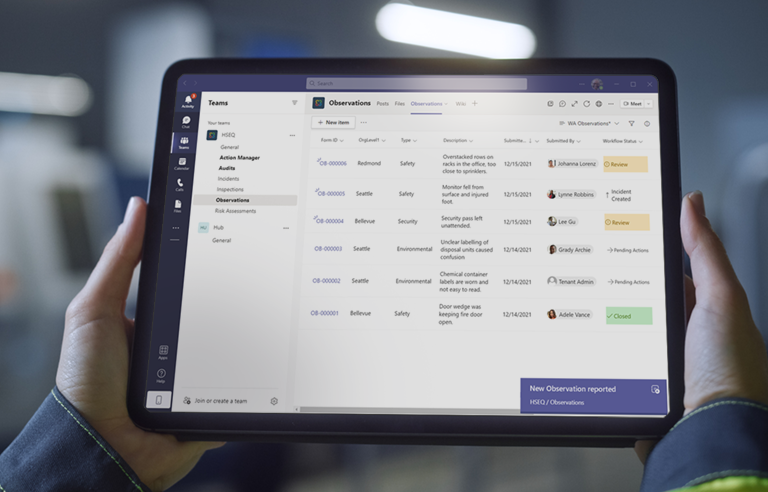Will the Microsoft Teams revolution make you rethink EHS software?


Recently, Teams became the fastest growing app in Microsoft’s history. It’s the new company hub for many organizations. So, what does it mean for environmental, health and safety leadership?
Traditionally, an issue with EHS management software is ease of access. Workplaces are safer when employees are engaged, but most proprietary EHS software sits separately from the rest of the business.
However, Microsoft Teams is focusing minds on the alternative. Because of the success of Teams, a huge opportunity exists to leverage Microsoft 365’s cultural acceptance among frontline workers to increase awareness of and engagement in EHS.
According to a Gallup Poll, workplaces with engaged employees have 70% fewer incidents. Granted, technology alone isn’t going to achieve this, but considering 145 million employees now use Teams every day, it’s a compelling tool to engage with frontline workers.
The problem with proprietary EHS management software
Most standalone EHS management software exists in a silo. This means access is limited, user skills may be specialized and it’s not an application most employees are logging into every day. In other words, barriers to EHS engagement.
To combat this, OSHA advises that safety software be easily accessible to everyone: "If a computerized reporting system is used, ensure that all employees have the basic computer skills and computer access sufficient to submit an effective report."
Now, with the rise of Teams raising the profile of Microsoft 365, it’s becoming clearer what the alternative to standalone EHS management software is.
Putting EHS where your employees are
Having your EHS software within Microsoft 365 is a bit like building your church near the town center. It’s about putting EHS management where the people are.
Wouldn’t you want your TV show to be on Netflix, or your food brand in the supermarket?
In this way, leveraging the apps that frontline workers use every day has tangible benefits. For example, at global logistics company LBC Tank Terminals, only around 10% of incident reports were coming from non-EHS staff. When the company switched to a Microsoft 365-based system, that figured jumped to 93% in the first year. Further, the business saw a 370% increase in near-miss reports after employees were given an easy way to take part.
As explained by Martin Hoogenraad, CSR manager:
Martin Hoogenraad
CSR Manager
LBC Tank Terminals
LBC Tank Terminals has since won several EHS and ESG awards for its focus on employee participation. Thus, we can start to see solutions to the long-standing barrier of access to EHS management. Time to do something about it?
But Teams isn’t built for EHS management?
With these undeniable benefits, why aren’t all organizations using Teams for EHS management? The truth is, Teams isn’t designed for this purpose.
As with SharePoint out of the box, Teams on its own lacks the depth of functionality to be an intuitive EHS management system for enterprises. Therefore, it cannot replace proprietary EHS software.
So, the question is: How can enterprises merge the power of proprietary EHS software with the accessibility of Teams?
One answer is to look at the bigger Microsoft 365 picture.
You may be surprised to learn that there is 365-based EHS software. For example, Pro-Sapien combines the power of proprietary EHS software with the accessibility of Microsoft 365. This method allows EHS to be present in Teams while drawing upon the functionality of SharePoint and Power BI. Benefits include:
- Faster access as a result of single sign on with 365 credentials
- Easy to fill in EHS forms without leaving Teams
- Quickly search and manage EHS SharePoint libraries in Teams
- The ability to see Teams online status of form owners and chat directly
- Collaborate on EHS Power BI reports in Teams
- Launch full Pro-Sapien SharePoint app in one click
In any case, you’re staying conveniently in Microsoft 365 with a consistent employee experience.
Microsoft Teams and 365 merits consideration of EHS leadership
As we’ve seen, Teams is core to the new world of work for millions of users. This is a paradigm shift for business, and leadership across all disciplines needs to consider the implications.
The success of Teams brings frontline workers to Microsoft 365 and presents a huge opportunity to promote EHS. Putting EHS software in the employee hub increases access, visibility and a sense of ownership for all involved. On the other hand, Teams itself isn’t fit for EHS management, so there are purpose-built Microsoft 365 applications that provide the best of both worlds.
Ultimately, putting EHS management in Microsoft 365 helps raise awareness of and engagement in EHS.
So, is the Teams revolution making you rethink EHS software? Discover more about Pro-Sapien Teams Integration today.
Post a comment to this article
Safety+Health welcomes comments that promote respectful dialogue. Please stay on topic. Comments that contain personal attacks, profanity or abusive language – or those aggressively promoting products or services – will be removed. We reserve the right to determine which comments violate our comment policy. (Anonymous comments are welcome; merely skip the “name” field in the comment box. An email address is required but will not be included with your comment.)

